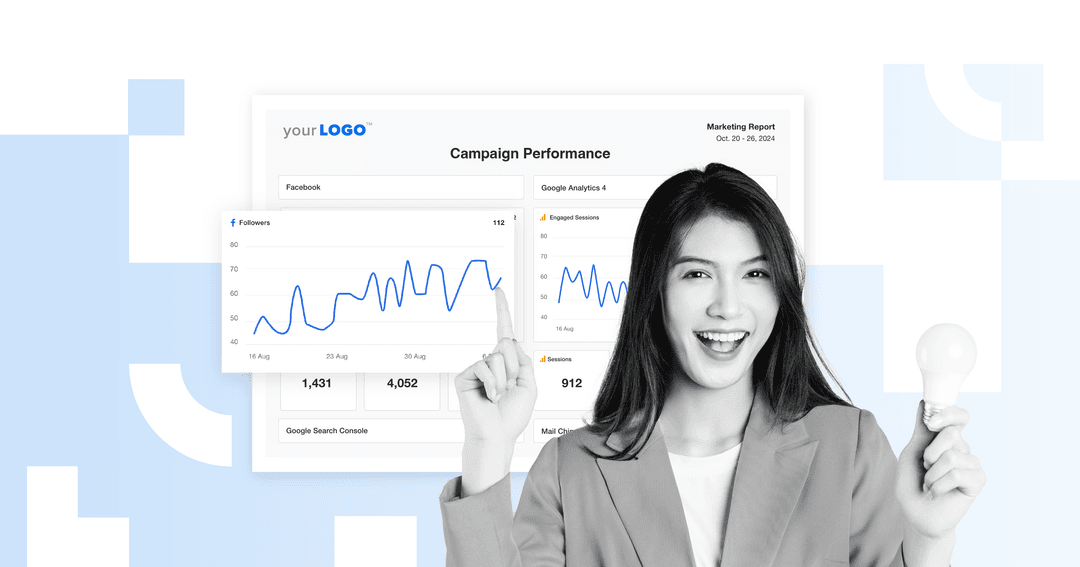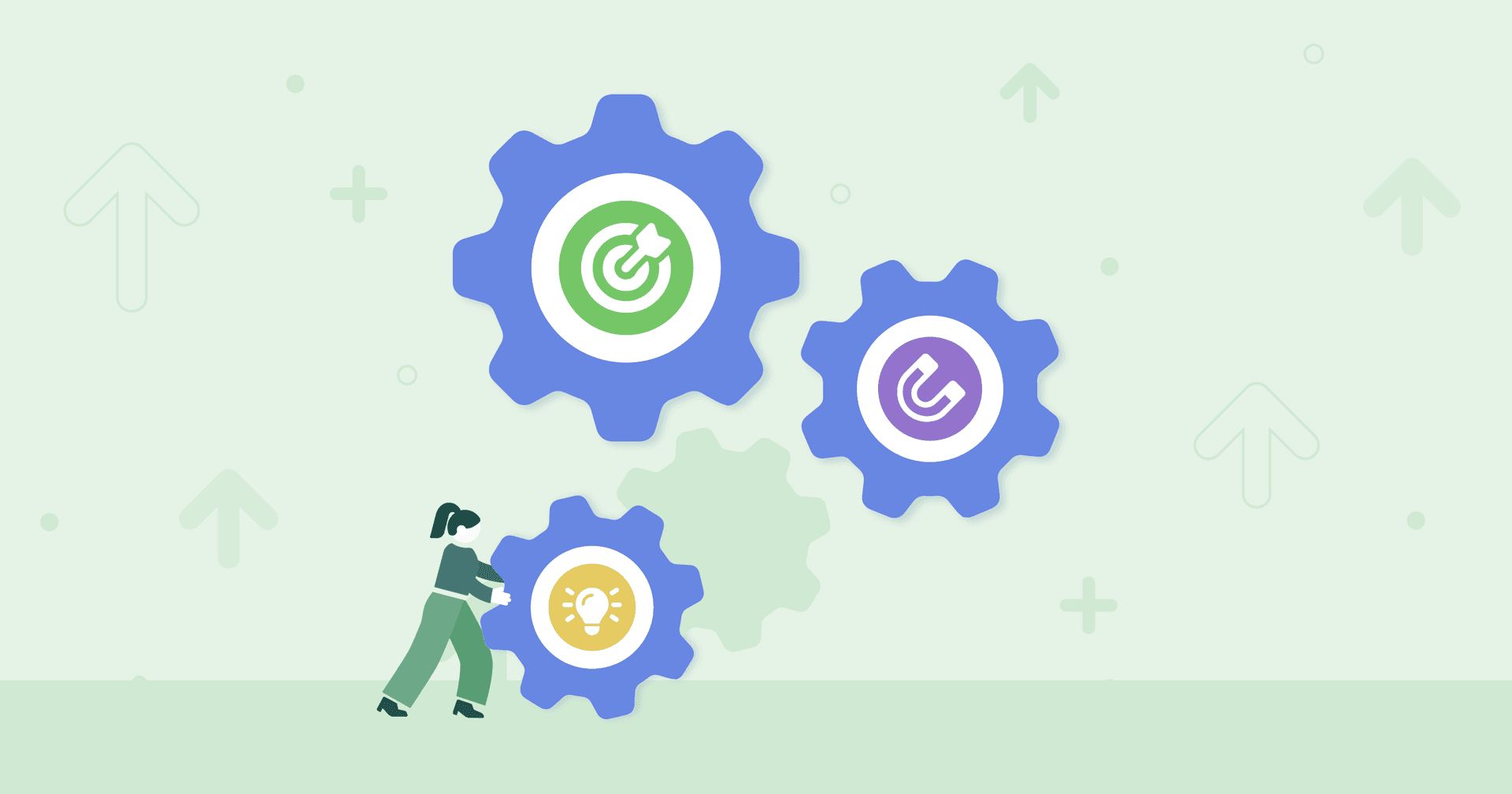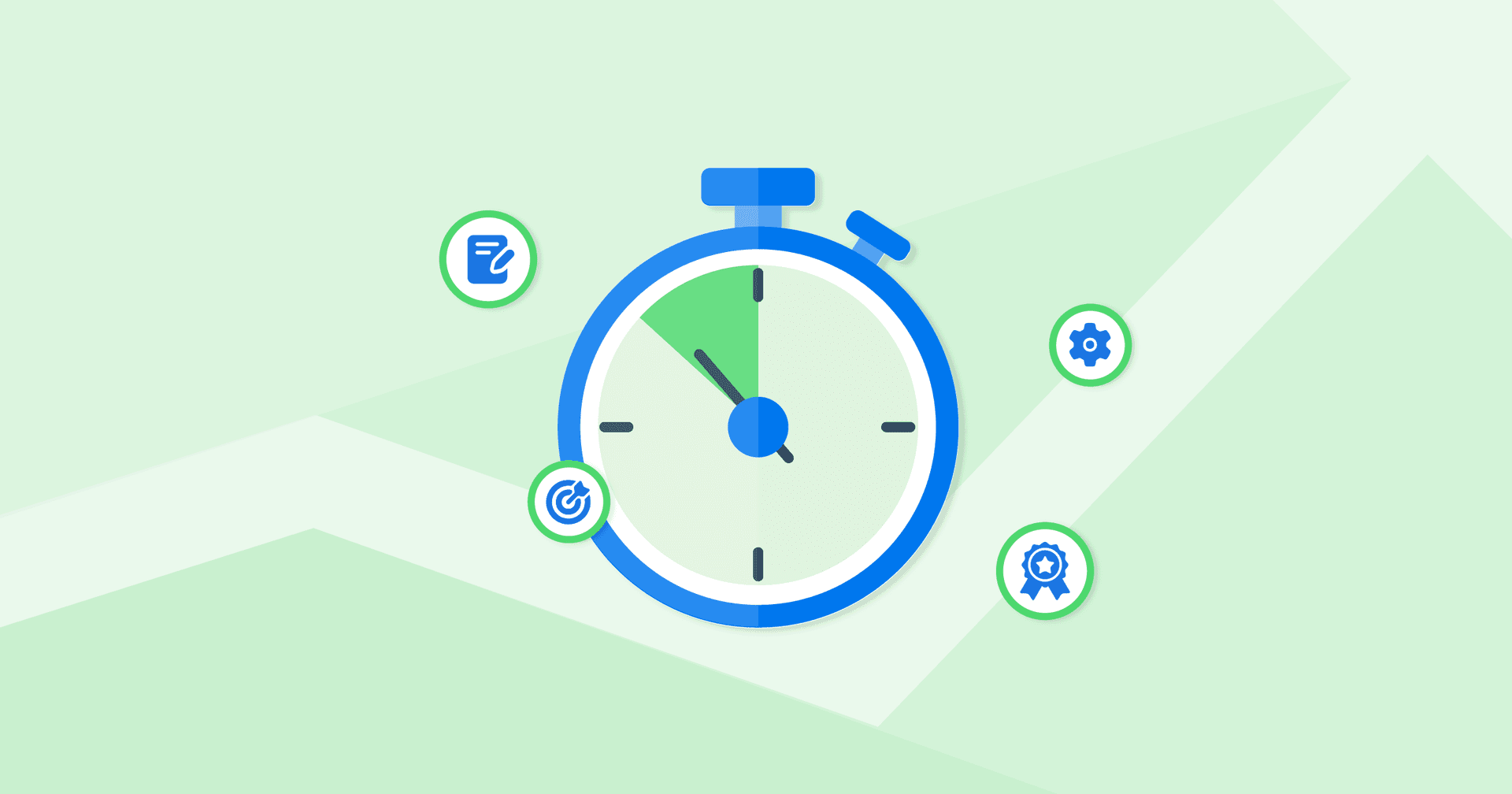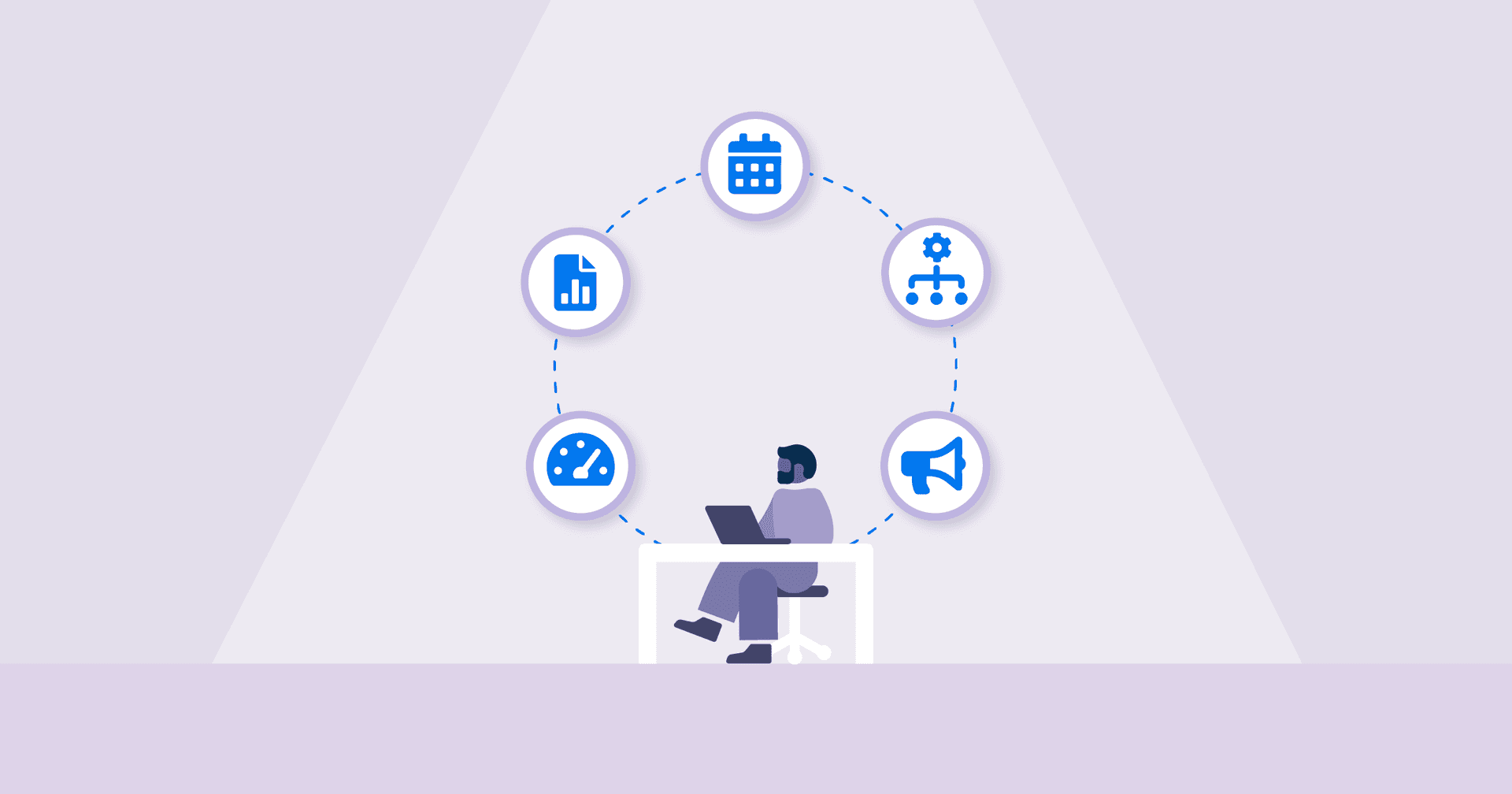Table of Contents
QUICK SUMMARY:
In this article, we share five ways to improve marketing performance, featuring insights from our network of agency leaders. Learn how top agencies refine their targeting, maximize ad spend, and prove ROI—so you can do the same.
You’re already an expert at designing and optimizing marketing strategies. You know the fundamentals like the back of your hand—choosing the right target audience, crafting compelling messaging, and tracking key performance indicators (KPIs). But running a high-performing agency isn’t just about developing creative concepts and fine-tuning multiple campaigns—it’s about efficiency.
Without the right systems, agencies waste time manually adjusting campaigns, explaining results to clients, and getting buried in reporting. That means less time for strategy, growth, and more profitable work.
Top agencies don’t just improve marketing campaigns—they optimize their entire process. In this article, we share five ways to improve marketing efficiency, prove ROI to clients, and scale your agency without adding extra hours to your workload.
What is Campaign Performance, Really?
Marketing campaign performance measures how effectively a campaign achieves its intended business goals—whether that’s generating leads, increasing sales, or improving customer retention.
It’s easy to focus on vanity metrics that look impressive in reports—things like high impressions, clicks, and engagement rates. But at the end of the day, a successful marketing campaign isn’t about these surface-level numbers. They might look good in a report, but they don't mean much if they don’t contribute to a client’s overall marketing strategy.
If clients can’t clearly see how your campaigns contribute to their bottom line, your agency’s value comes into question, even if the campaign itself is technically "working."
So, campaign performance isn’t just about running successful campaigns—it’s about proving their impact in a way that keeps clients invested for the long haul.
3 Ways Marketing Campaign Performance Makes or Breaks Your Agency
With this definition in mind, let’s examine why marketing campaign performance is critical to your agency’s success and scalability.
1. Clients Won’t Stay If They Can’t See ROI
Too many marketing teams pour hours into optimization and reporting but still struggle with client retention because the numbers that truly matter, like ROI, customer acquisition costs, and revenue impact—aren’t front and center.
If clients don’t understand the value of your work, they won’t hesitate to take their marketing budget elsewhere. This isn’t a risk any agency can afford. According to our annual Marketing Agency Benchmarks Survey, client acquisition has been the top agency challenge for two years in a row.
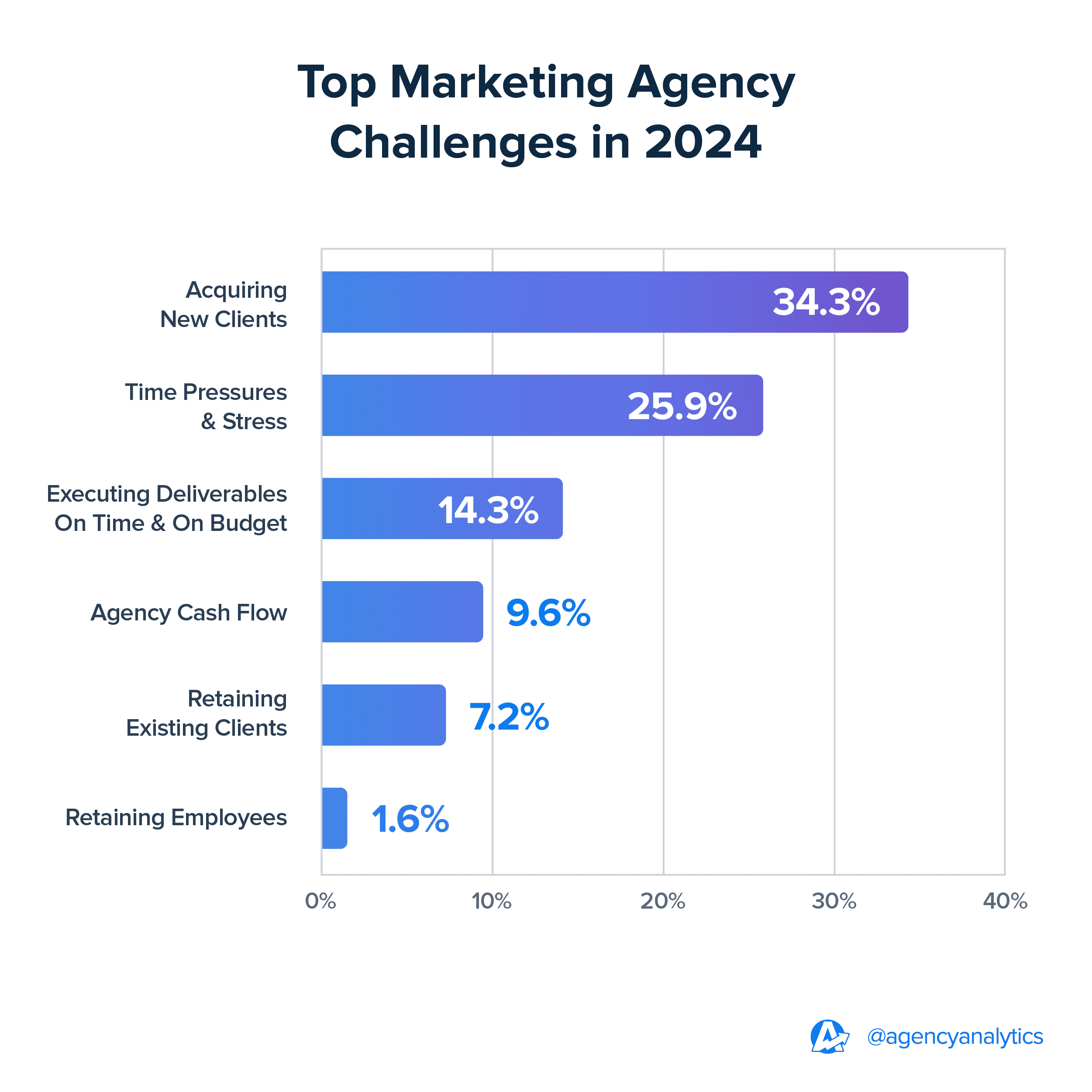
Competition is as fierce as ever and acquiring a new client costs 5-7 times more than retaining an existing one.
These statistics underscore the importance of demonstrating clear ROI to retain clients and enhance profitability.
2. Wasted Budget Hurts Both Clients and Your Profit Margins
Wasted ad spend doesn’t just hurt your clients—it eats into your agency’s profit margins too. Every inefficient campaign means lost time, fewer billable hours, and less room to focus on high-value work.
If your team is stuck manually adjusting campaigns, constantly shifting budgets, or explaining underperformance, here’s what’s really happening:
You’re wasting time on tasks that should be automated.
You aren’t optimizing budgets for the highest ROI.
Your agency’s growth is getting bottlenecked by slow reporting.
3. Scalable Campaign Performance Fuels Agency Growth
Many agencies struggle to grow because their campaign management process lacks efficiency. When every campaign requires manual adjustments, constant troubleshooting, and time-consuming custom reporting, bandwidth disappears, and profitability declines.
A structured approach to campaign performance allows teams to focus on strategy, marketing automation, and proactive improvements rather than reactive problem-solving. With the right systems in place, your agency can take on more clients without increasing workload at the same rate.
Related: 14 Ways To Improve Your Marketing Agency
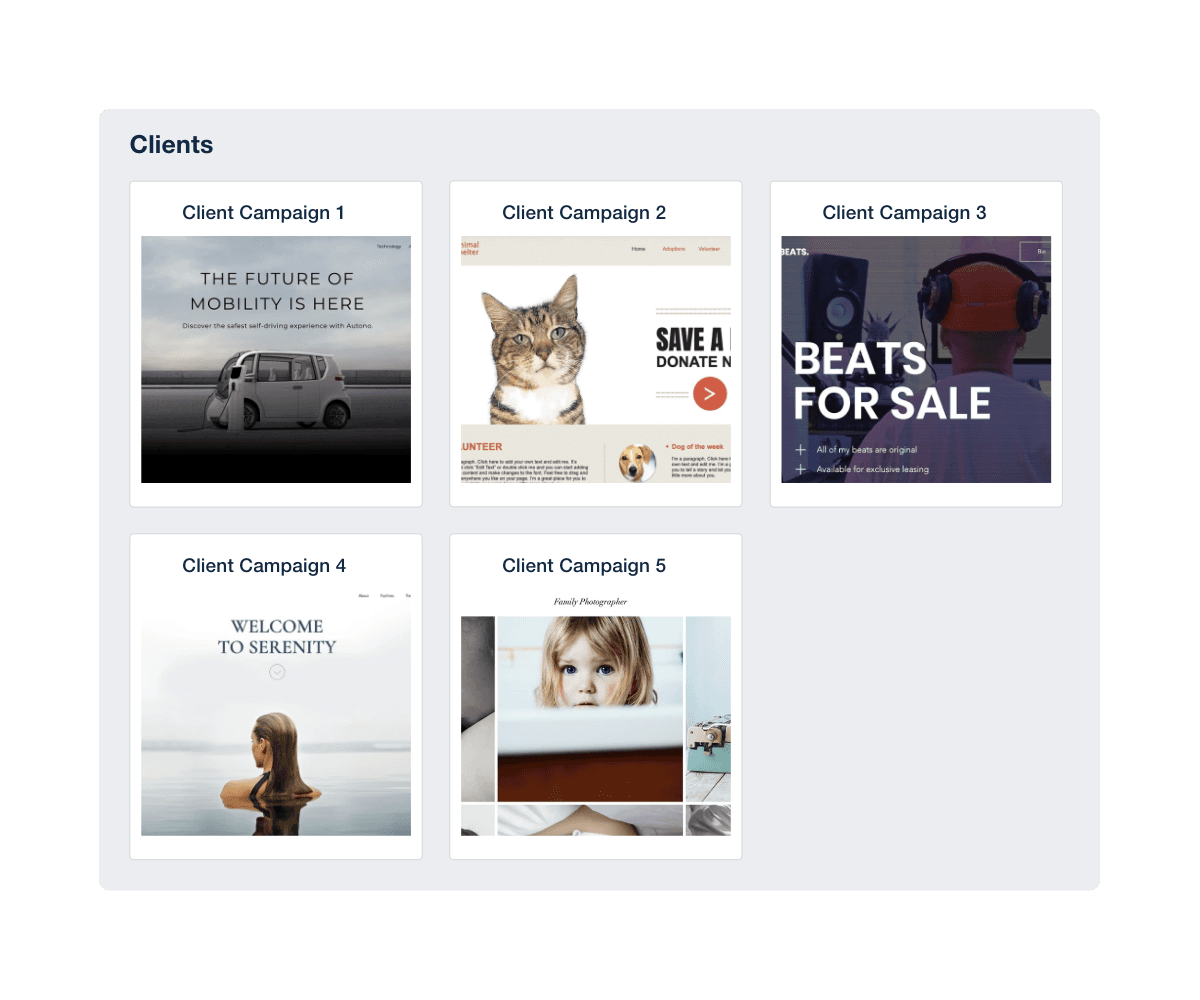
Streamline your entire reporting process with an all-in-one reporting tool that allows you to manage all your clients in one place. Try AgencyAnalytics free for 14 days.
How To Improve Agency Marketing Campaign Performance
Now let’s explore how to improve marketing campaign performance in a way that drives long-term success.
1. Refine Audience Targeting To Reduce Wasted Ad Spend
One of the biggest reasons agencies waste budget and see lower conversions is setting audience targeting parameters once and never revisiting them. Continuous refinement ensures that you focus ad spend on high-intent users, maximizing conversion rates and ROI.
Key Strategies for Smarter Audience Targeting
Here are a few ways to improve campaign performance through refined targeting efforts:
Behavior-Based Targeting: Identify who is already interacting with your client’s brand and focus ad spend on high-intent audiences.
First-Party Data Segmentation: Use website visitor data, past customer purchases, and email engagement metrics to retarget warm prospects who have already shown interest.
Lookalike Audiences: Expand reach by creating lookalike audiences that mirror existing high-value customers. This ensures you attract the right prospects instead of random traffic.
One of our customers put this strategy into action with impressive results. Squidgy, a Newcastle-based digital marketing agency specializing in SEO, PPC, and Paid Social, partnered with a top North East tourist attraction to re-engage website visitors who hadn’t converted. Squidgy’s team leaned into hyper-specific targeting and standout creative assets to drive higher conversions—more efficiently.
In terms of differentiating factors that made this campaign unique, the targeting was extremely specific. This, coupled with outstanding creatives, set us up for great success. As a result, we managed to increase ROAS by 9% whilst spending less than the previous year.
Sam Yielder, Senior Paid Media Manager, Squidgy
This campaign is proof: Refining your target audience is key to improving digital marketing performance.
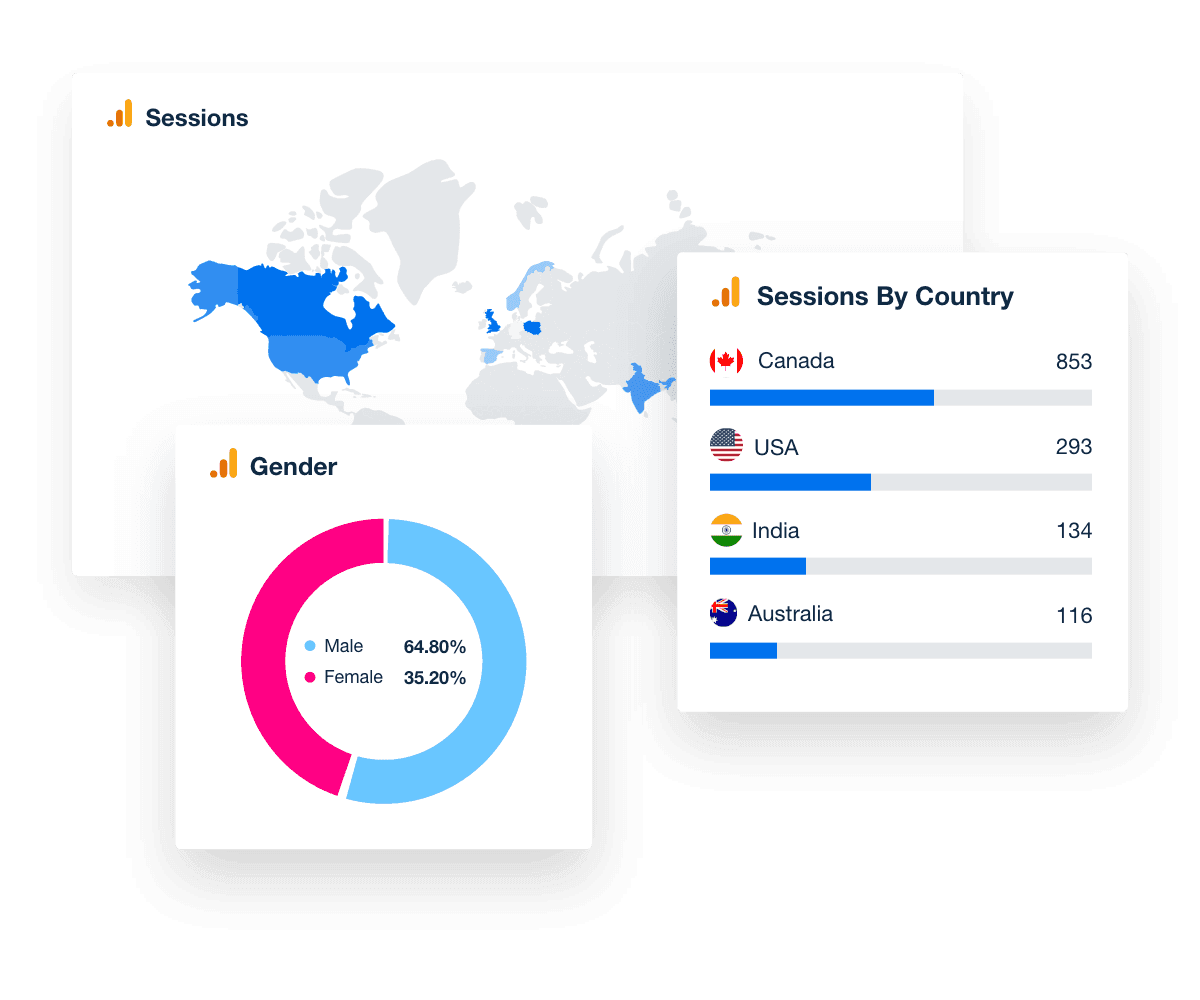
Bring all your clients’ first-party data under one roof by combining Google Analytics with over 80 other marketing platforms. Start your free 14-day trial today.
Another tip—even the best-targeted campaigns underperform when the Ideal Customer Profile (ICP) isn’t fully dialed in. Revisiting your client’s ICP keeps your targeting sharp, aligns messaging with their pain points, and improves ad efficiency.
AGENCY TIP: Download our ICP Template to build a precision-targeted profile that eliminates wasted spend and improves conversions.
2. Set Clear, Realistic KPIs That Clients Care About
One of the most common mistakes agencies make is presenting clients with marketing metrics without tying them to real business impact. KPIs must align with your client’s specific business goals.
Each of our clients and campaigns has specific goals that they want to achieve. To accurately track the performance of these campaigns, we choose the most relevant metrics. For example, when trying to build brand awareness, a few key metrics that we track are follower growth and engagement.
Bri Bernard, Director, Studio Blackardt
Key Metrics to Track
So, what KPIs do clients care about most? According to the AgencyAnalytics 2024 Agency Benchmarks Survey, 75% of clients run conversion-driven campaigns. That means they’re most interested in the following marketing metrics:
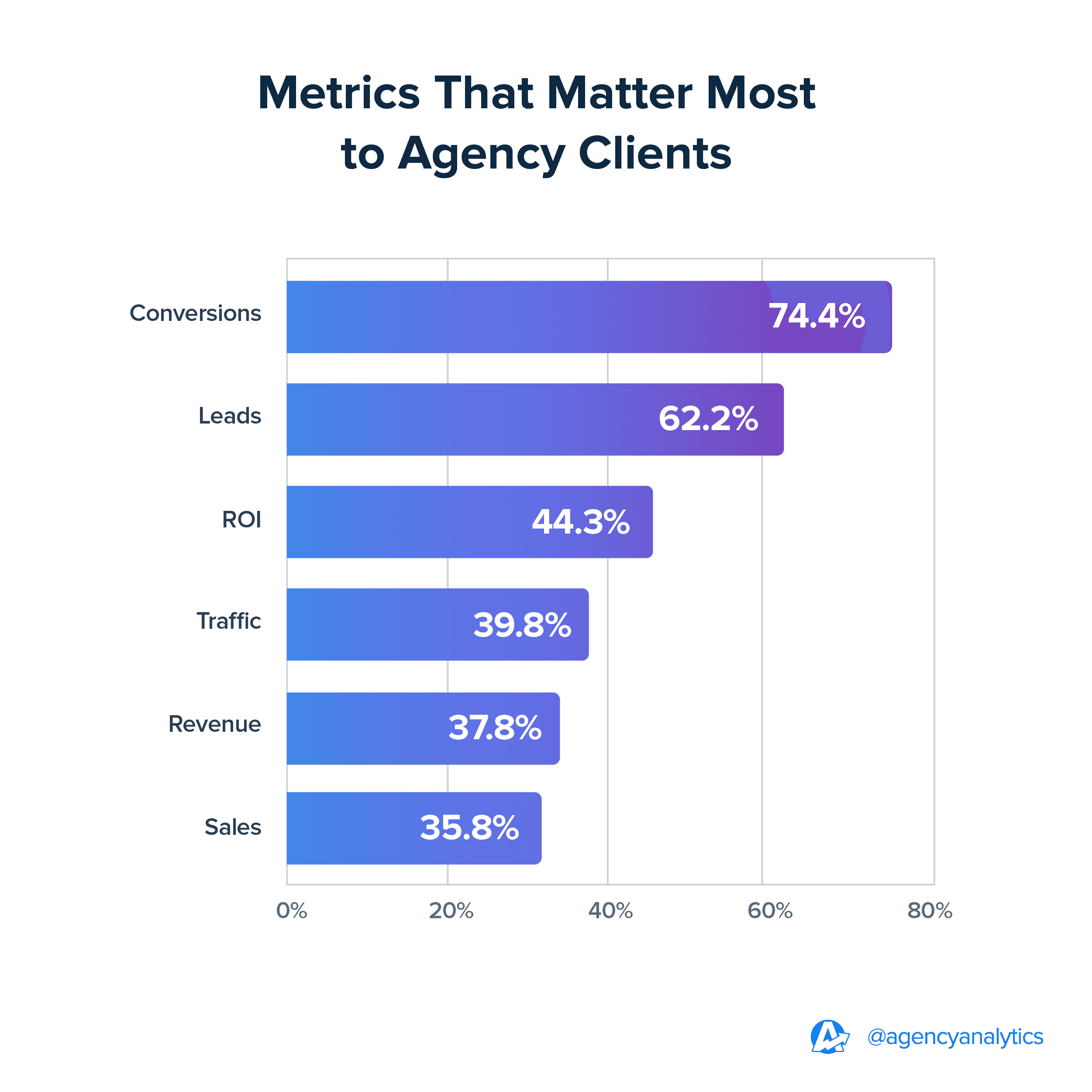
The right marketing metrics depend on what your client is trying to achieve. Here’s a quick reference table to help you align business objectives with the KPIs that matter most:
Client Goal | Key Campaign Performance Metrics to Track |
|---|---|
Increase Brand Awareness | Impressions, Reach, Follower Growth, Social Engagement, Share of Voice. |
Generate More Leads | Conversion Rate, Cost per Lead (CPL), Lead Quality Score, Form Submissions. |
Improve Website Performance | Bounce Rate, Time on Page, Pages per Session, Goal Completions. |
Increase Online Sales | Return on Ad Spend (ROAS), Cost per Acquisition (CPA), Average Order Value (AOV). |
Boost Customer Retention | Customer Lifetime Value (CLV), Repeat Purchase Rate, Churn Rate. |
Improve SEO Rankings | Organic Traffic, Keyword Rankings, Domain Authority, Backlinks. |
Optimize Email Marketing | Open Rate, Click-Through Rate (CTR), Unsubscribe Rate, Email Conversions. |
Maximize Paid Ad Efficiency | Click-Through Rate (CTR), Cost per Click (CPC), Quality Score, ROAS. |
Use Industry Benchmarks To Identify Achievable KPIs
Knowing which marketing metrics to track is one thing. Simply relying only on internal historical data may lead to misaligned campaign goals—either setting expectations too high and missing targets or aiming too low and leaving opportunities on the table.
Without industry benchmarks, your KPIs might be too ambitious—or too easy. To avoid this, use real data to set the right targets. Let’s say a client’s primary goal is brand awareness on social media platforms, and you’ve identified Facebook engagement rate as a key metric. Without industry benchmarks, how do you determine what qualifies as strong performance?
AgencyAnalytics’ insights feature provides industry-specific data points based on first-party customer data from thousands of agency campaigns. According to this data, the median Facebook post engagement rate is 1.27%.
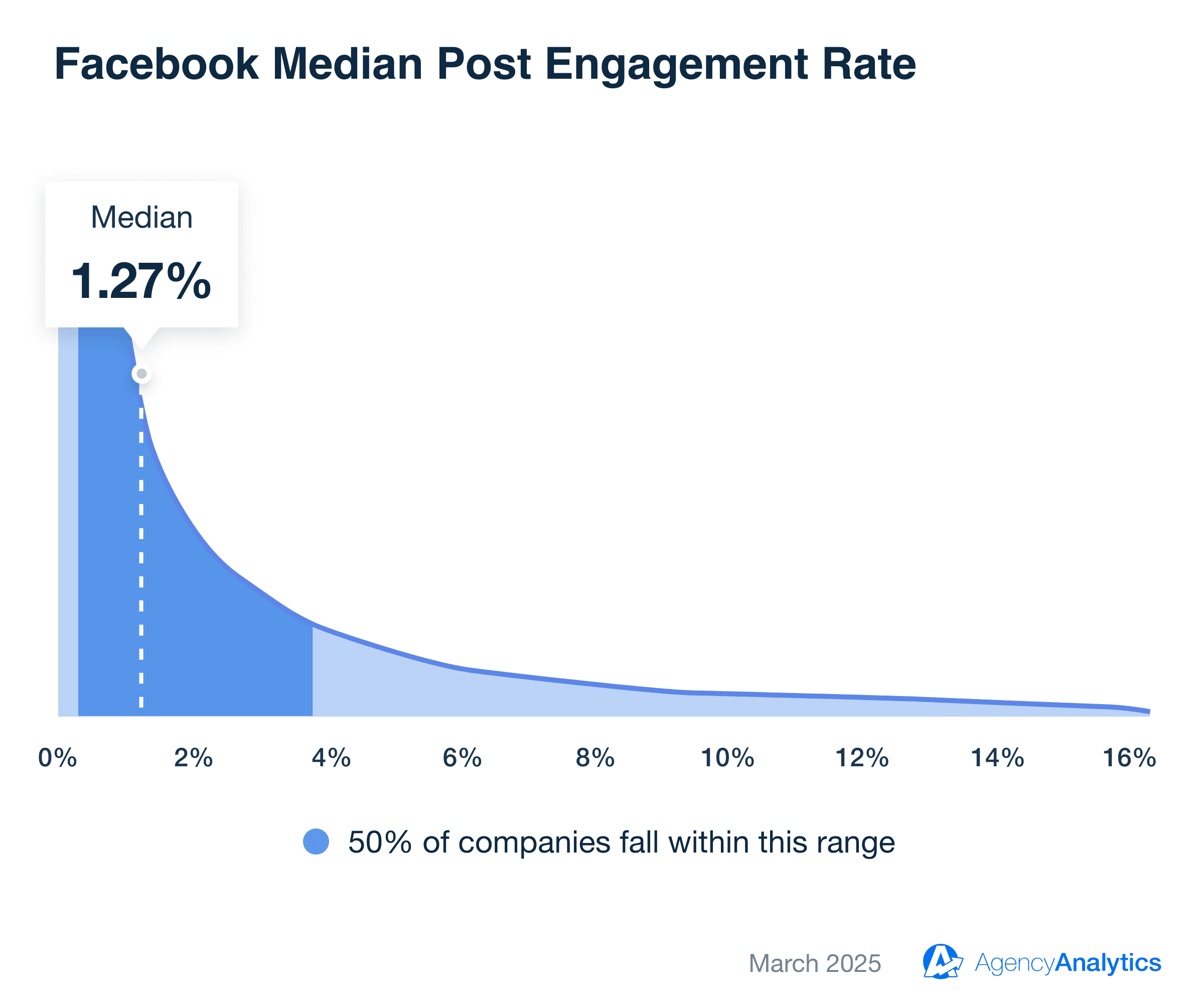
But industry-specific benchmarks paint an even clearer picture:
Facebook Engagement Rate By Industry
Industry | Facebook Post Engagement Rate |
|---|---|
Advertising & Marketing | 0.33% |
Animals & Pets | 1.28% |
Apparel & Fashion | 1.19% |
Arts & Entertainment | 1.34% |
Attorneys & Legal Services | 0.90% |
Automotive Parts & Services | 0.63% |
Beauty & Personal Care | 1.29% |
Business Services | 0.67% |
Career & Employment | 0.98% |
Dental Services | 1.28% |
Education | 2.59% |
Environment & Sustainability | 1.31% |
Event & Entertainment | 1.64% |
Finance & Insurance | 0.57% |
Food & Beverage | 0.91% |
Furniture | 1.45% |
Health & Fitness | 2.21% |
Home Improvement | 1.58% |
Industrial & Commercial | 1.07% |
Manufacturing & Industrial | 0.87% |
Non Profit | 1.17% |
Real Estate | 2.34% |
Restaurants | 1.35% |
Sports & Recreation | 1.60% |
Travel | 1.50% |
Data is knowledge! Use these benchmark insights to:
Assess Performance: Compare campaign results to industry-specific data to determine whether KPIs are on track.
Justify Recommendations for Marketing Strategies: Show clients how their results compare to similar businesses, reinforcing the value of your agency’s work.
Set Data-Backed Goals: Use real-world industry data to ensure targets are both ambitious and achievable.
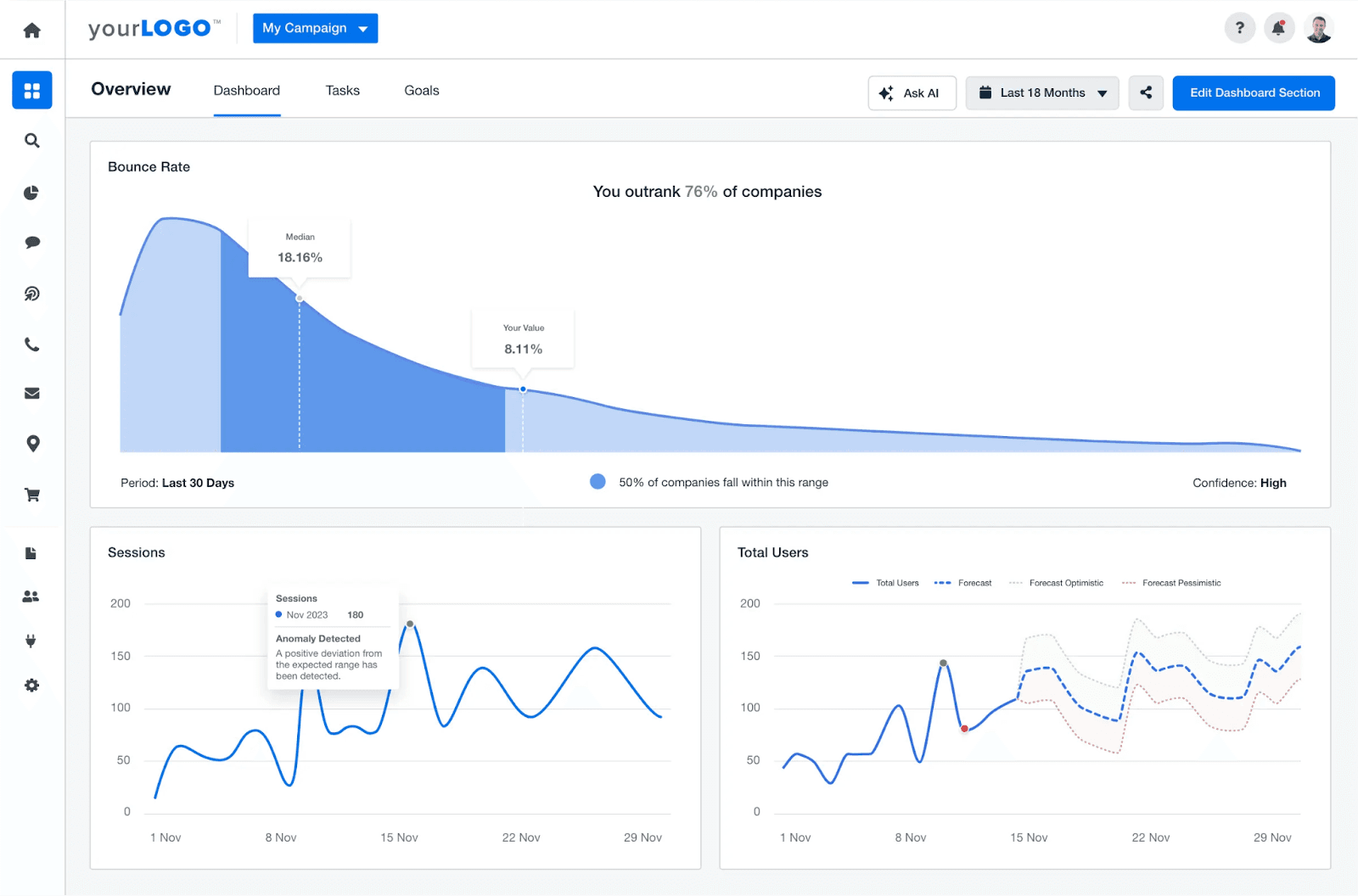
Improve your marketing efficiency—see how your campaigns stack up with the insights features from AgencyAnalytics.
3. Focus on the Right Channels, Not Every Trend
It’s tempting to be everywhere at once—spreading budgets across every platform just to “cover all bases.” But that’s a surefire way to waste ad spend and struggle to prove ROI.
Instead of chasing every new trend, high-performing agencies refine their marketing strategies based on accurate data. Whether they invest in a proven social media platform or reallocate budgets to high-ROI search campaigns, the key is optimizing what already works.
Data-driven decision-making is what makes this possible. Rather than making assumptions about which channels will perform best, analyze existing performance metrics and competitor insights to determine where to invest your client’s budget.
Use Competitor Analysis To Identify High-ROI Opportunities
Your client’s competitors’ success (or failure) is one of the most valuable indicators of where to focus your efforts. Instead of starting from scratch on every platform, analyze where top-performing competitors are getting results you can replicate.
Doing competitor analysis helps us stay in touch with what platforms, ad formats, keyword targeting, and creative ideas the competition is using. We gain insights into our own campaign success or failure, set benchmarks, and stay ahead–if we're doing the best. It also gives us ideas for new areas, platforms, or ad formats to use for our own marketing that we may not have tried yet.
Stuart Pereira, Campaign Manager (Paid Marketing), WSI Comandix
Actionable Ways to Use Competitor Insights
Identify Gaps in Their Strategy: Are competitors underutilizing organic search, video content, or paid search while overinvesting in social? This is an opportunity to differentiate and capture untapped market share.
See Where They’re Winning: Which marketing channels consistently bring in engagement, leads, or conversions for your competitors? If they’re scaling efforts on a particular platform, there’s a reason—reverse-engineer their strategy to optimize your own.
Analyze Ad Placements and Messaging: Study competitor ad copy, audience targeting, and campaign frequency to refine your own paid strategies and outperform them.
Refine Your SEO Strategy for Long-Term Wins
While social media platforms and paid ads drive quick results, search engine optimization (SEO) is a powerful long-term play. If your client’s site isn’t optimized, they’re losing out on organic traffic that converts at a lower cost.
Here’s how to strengthen your marketing campaign strategy with SEO:
Optimize Key Pages: Ensure landing pages include relevant keywords, fast load speeds, and clear CTAs to rank higher and drive potential customers organically .
Create Content That Ranks: Remember that blogging is about targeting the right audience with high-value, keyword-optimized content that builds trust and authority.
Build Backlinks for Authority: Google sees backlinks as trust signals. Secure links from industry sites to boost rankings and marketing campaign performance.
Unlike paid ads, SEO delivers compounding returns over time. The earlier you invest, the bigger the long-term payoff.
4. Optimize Campaign Timing for Maximum Conversions
Too many agencies launch campaigns based on deadlines—not data. The problem is that’s how you miss significant opportunities and see weak results.
Instead of randomly picking dates, refine your marketing campaign strategy using data-driven insights. Use Google Trends, historical analytics, and industry benchmarks to pinpoint when your audience is most engaged. Then, shift budgets accordingly to maximize conversions.
Here’s how to take a data-driven approach to campaign timing:
Analyze Historical Data: Dive into past performance to pinpoint when your client's industry's conversion rates and engagement metrics peak. Review Google Analytics, CRM reports, and past ad performance to identify seasonal trends. Look at conversion rates by month, week, and even day to find the highest-performing windows.
Use Google Trends to Predict Demand Spikes: Consumers don’t just buy impulsively; they research and compare options before making purchasing decisions. Google Trends reveals when search volume surges for industry-specific keywords, signaling when audiences are most engaged. For example, holiday shoppers often begin searching for deals weeks before major sales events, meaning pre-sale advertising can improve conversion rates.
Adjust Budgets Dynamically: Instead of allocating the same ad spend every month, shift budget toward peak engagement periods and scale back during slower times. Increase bids on high-intent search queries when conversion likelihood is highest. Lower ad spend during periods of low consumer demand to avoid wasted budget.
Agencies that align marketing campaigns with real consumer behavior—not arbitrary timelines—see higher engagement, stronger conversion rates, and more efficient marketing budget allocation.
5. Continuously Test Customer Behavior
A well-defined ICP is only the starting point—understanding what actually drives them to take action is where real campaign success happens. Continuous A/B testing is the key to uncovering what resonates most with your client’s audience and scaling the highest-performing strategies.
Many agencies make the mistake of assuming they know what works based on past experience with existing customers. But consumer behavior evolves, market conditions shift, and what worked last year might not be as effective today. The only way to ensure continuous campaign improvement is by systematically testing and optimizing marketing campaign elements.
What To Test in Your Marketing Campaigns
Landing Page Design: Small changes in layout and structure significantly impact conversions. Split test button placements, headlines, form lengths, and CTA copy. Experiment with single-step vs. multi-step forms to reduce friction.
Ad Copy & Visuals: Messaging and creative elements influence engagement and click-through rates. Test emotion-driven messaging vs. data-driven messaging to see what resonates most. Try different ad visuals, video lengths, and color schemes to determine the strongest performers.
Audience Segments: Not all customers respond the same way. Compare warm vs. cold audiences to determine where ad spend is most effective. Test broad vs. hyper-targeted audience groups to optimize reach and efficiency.
Winning A/B Testing Framework for Agencies
Dedicate at least 20% of Ad Spend to A/B Testing: Testing requires sufficient budget allocation to generate meaningful results.
Scale Winning Variations: Once a specific ad creative, landing page, or audience segment proves to be a top performer, allocate more budget to maximize ROI.
Rinse and Repeat: Continuous testing is key to optimizing campaigns as audience behaviors evolve. Never assume a “winning” variation will work forever—test new elements regularly to stay ahead.
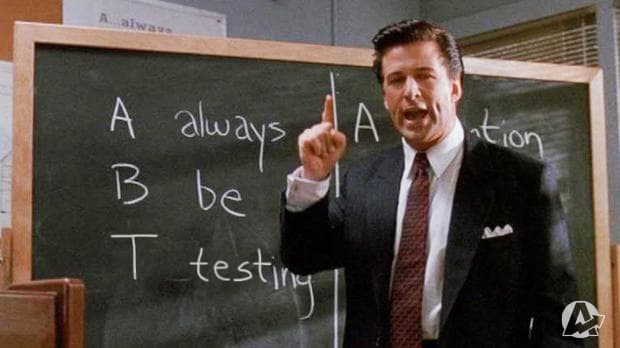
Treating A/B testing as an ongoing strategy rather than a one-time experiment drives higher conversion rates, lower CPA, and stronger long-term marketing campaign performance.
Track Performance Metrics and Improve Marketing Campaign Performance With AgencyAnalytics
Without the right marketing analytics platforms, manual reporting, fragmented data, and inconsistent data drains billable hours and limits scalability.
With real-time insights and automated reporting, AgencyAnalytics helps agencies improve performance, streamline operations, and retain more clients.
Automate Performance Reports Without the Extra Work: Instead of spending hours assembling reports, generate customized, white label reports in minutes. Automated scheduling ensures that clients receive clear, data-driven insights directly in their inboxes—helping you cut reporting time while reinforcing the value of your work.
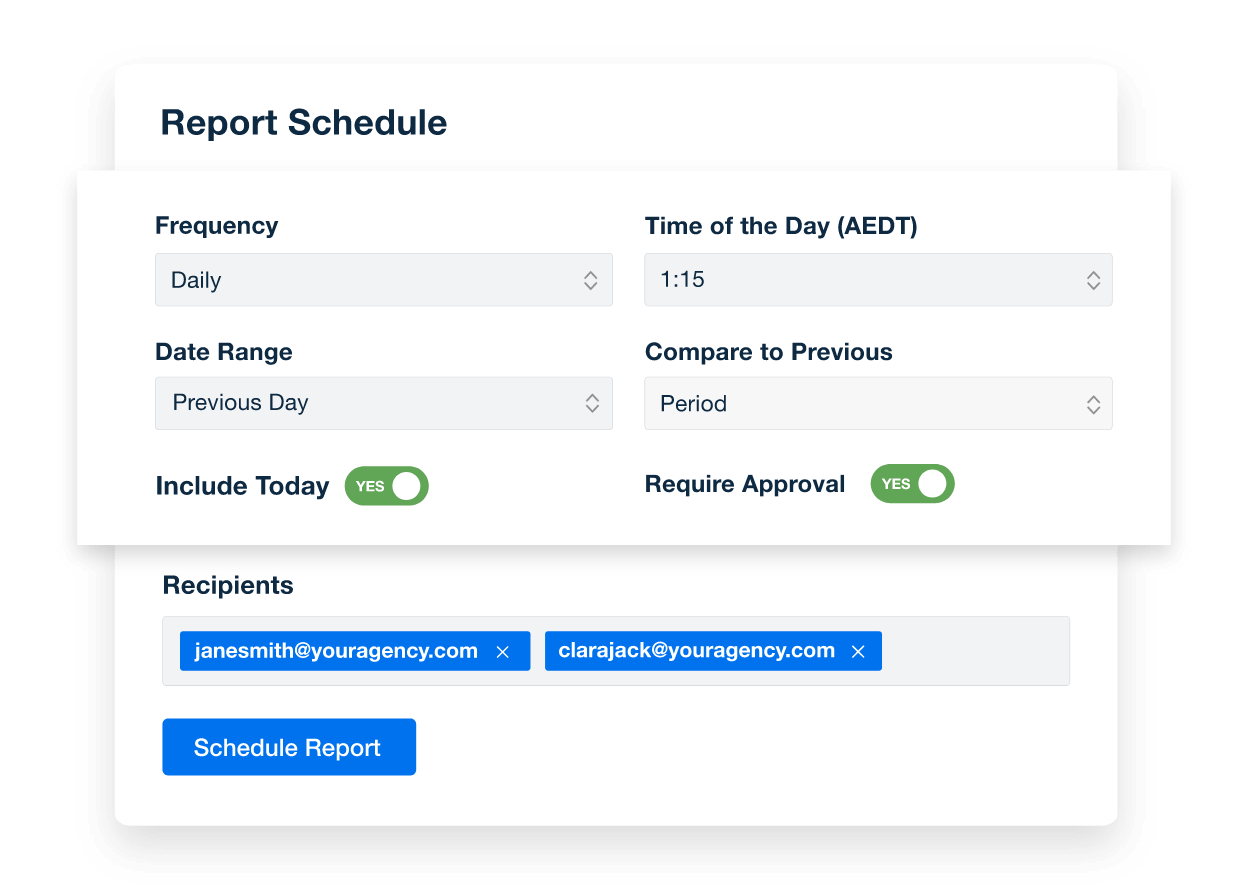
Monitor Cross-Channel KPIs in One Place: No more jumping between platforms. AgencyAnalytics integrates data from Google Ads, Facebook Ads, LinkedIn, search engine optimization tools, website analytics tools, and more, providing a single, unified marketing analytics dashboard. Compare performance across platforms, spot trends early, and make real-time adjustments before results suffer.
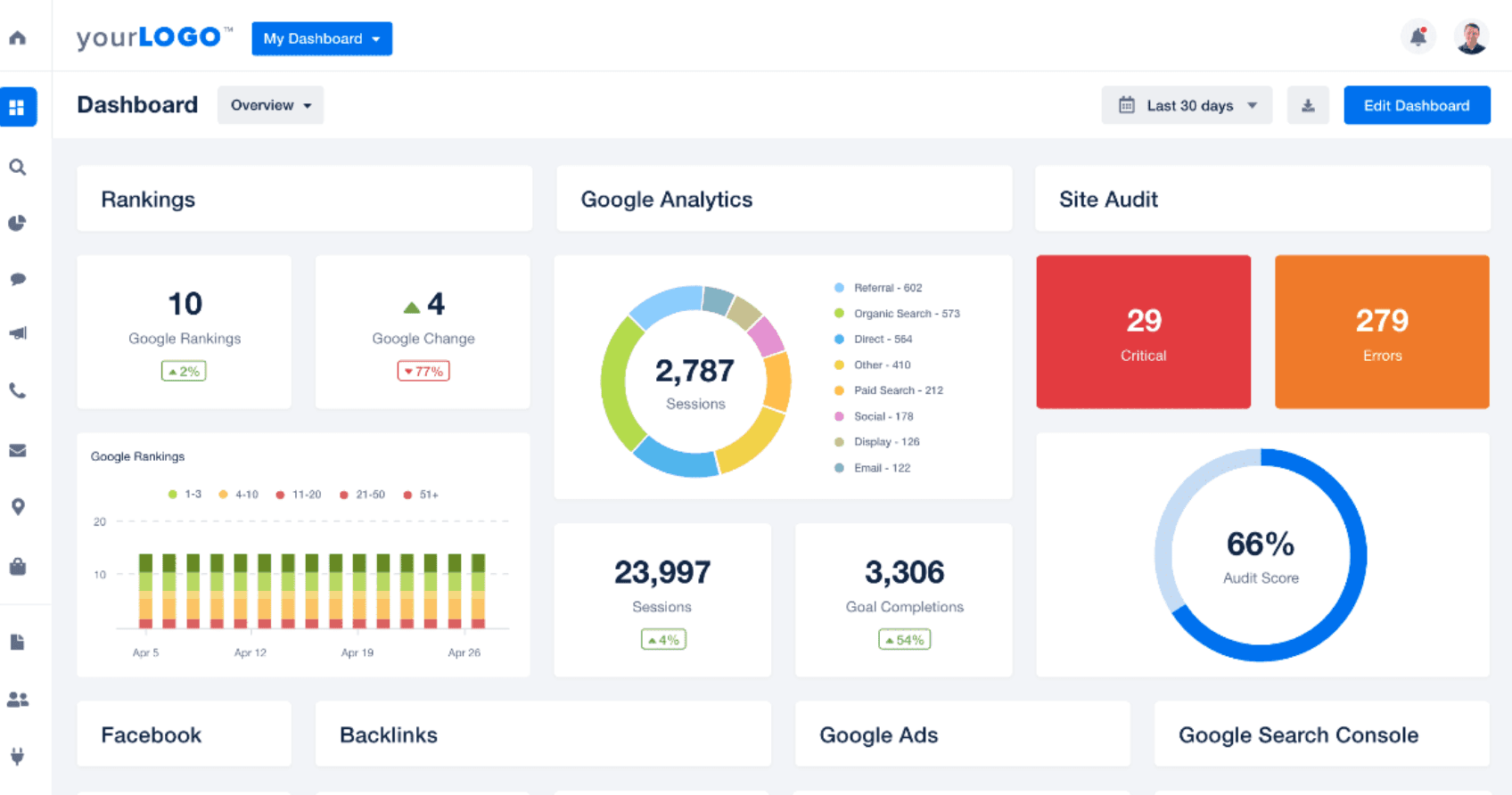
Scale Efficiently Without Adding Overhead: Growth shouldn’t mean more manual work. AgencyAnalytics helps you standardize reporting, eliminate repetitive tasks, and deliver real-time insights—allowing your team to manage more clients without increasing workload.
The Key To Running Scalable, High-Performing Campaigns
Scaling your agency is about running your campaigns smarter. By refining targeting, setting the right KPIs, optimizing channel selection, and continuously testing, you’ll improve your marketing efficiency and prove ROI to clients. And with the right tools in place, you’ll do it all without adding extra workload.
Ready to improve your marketing performance with streamlined reporting? Try AgencyAnalytics free for 14 days.

Written by
Sylva is an expert content writer with over 10 years of experience in tech and SaaS, offering first-hand insight into agency needs from her background in advertising.
Read more posts by Sylva SivzattianSee how 7,000+ marketing agencies help clients win
Free 14-day trial. No credit card required.



